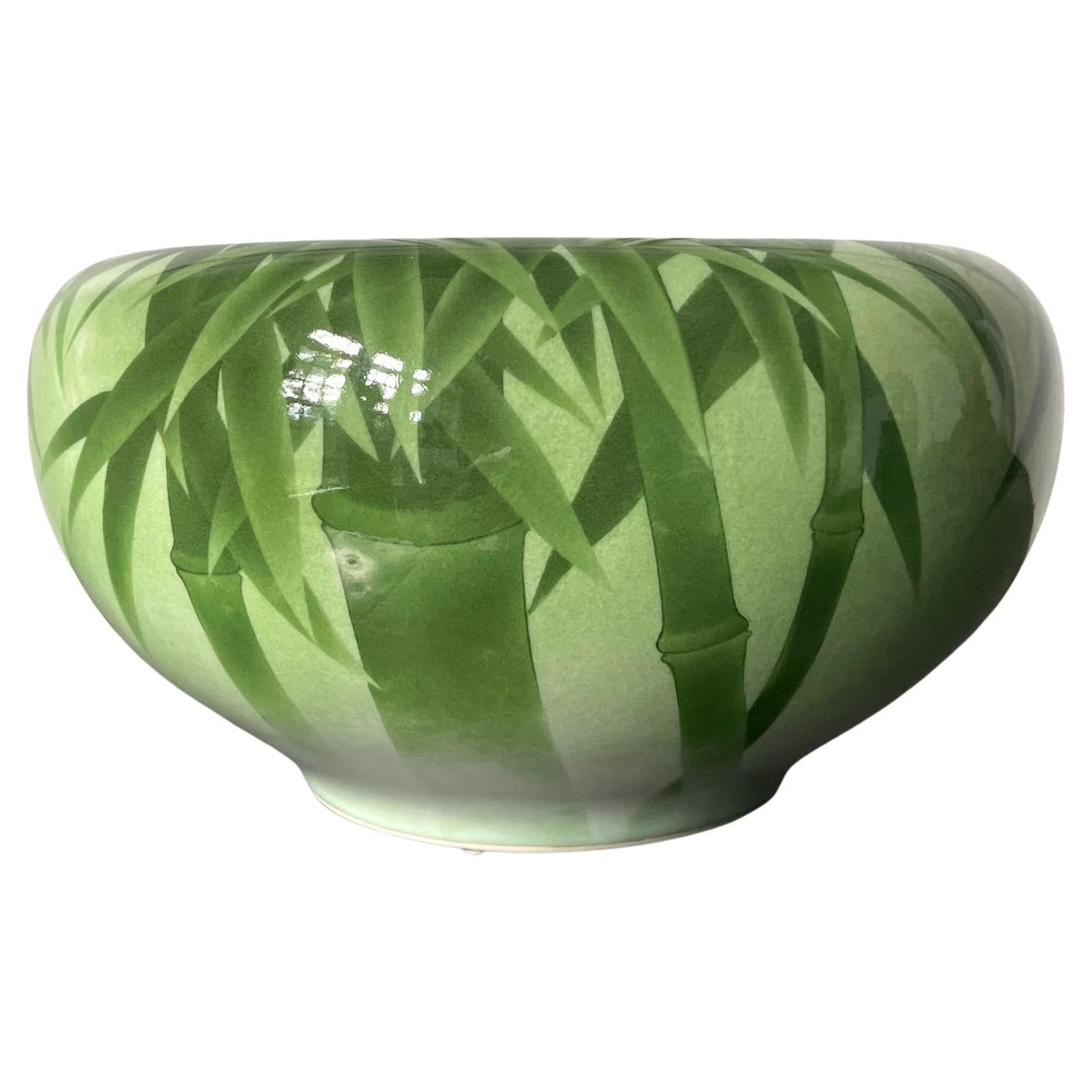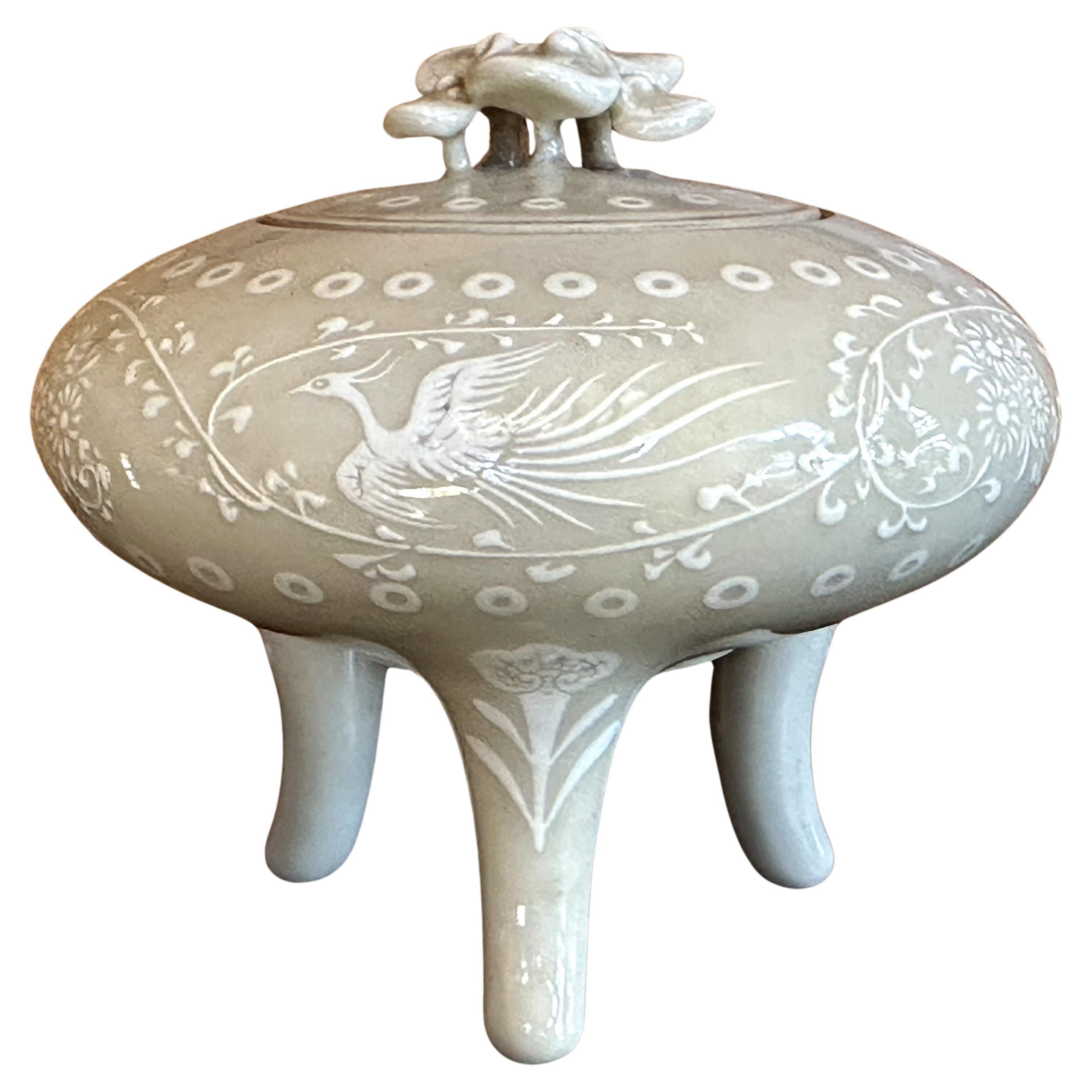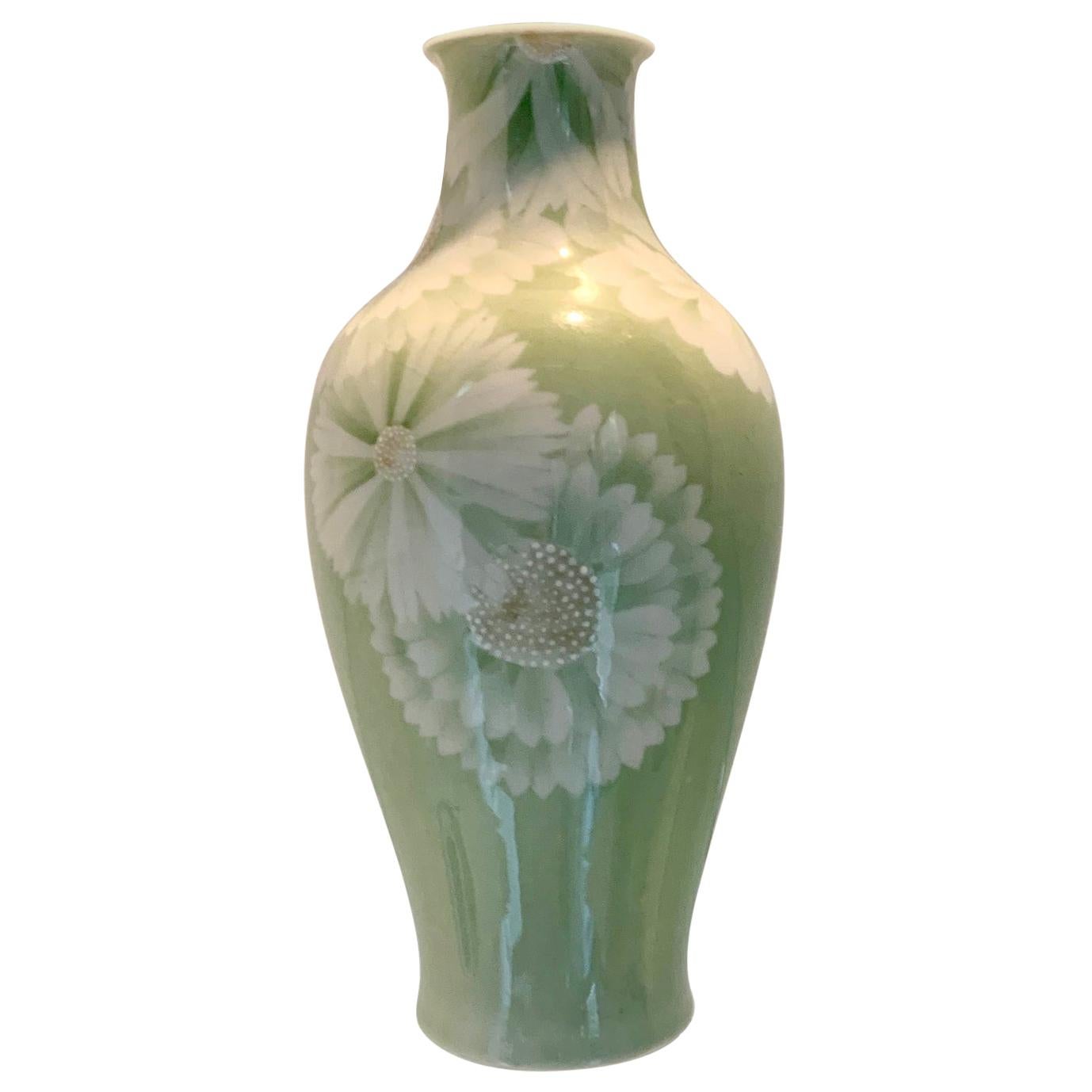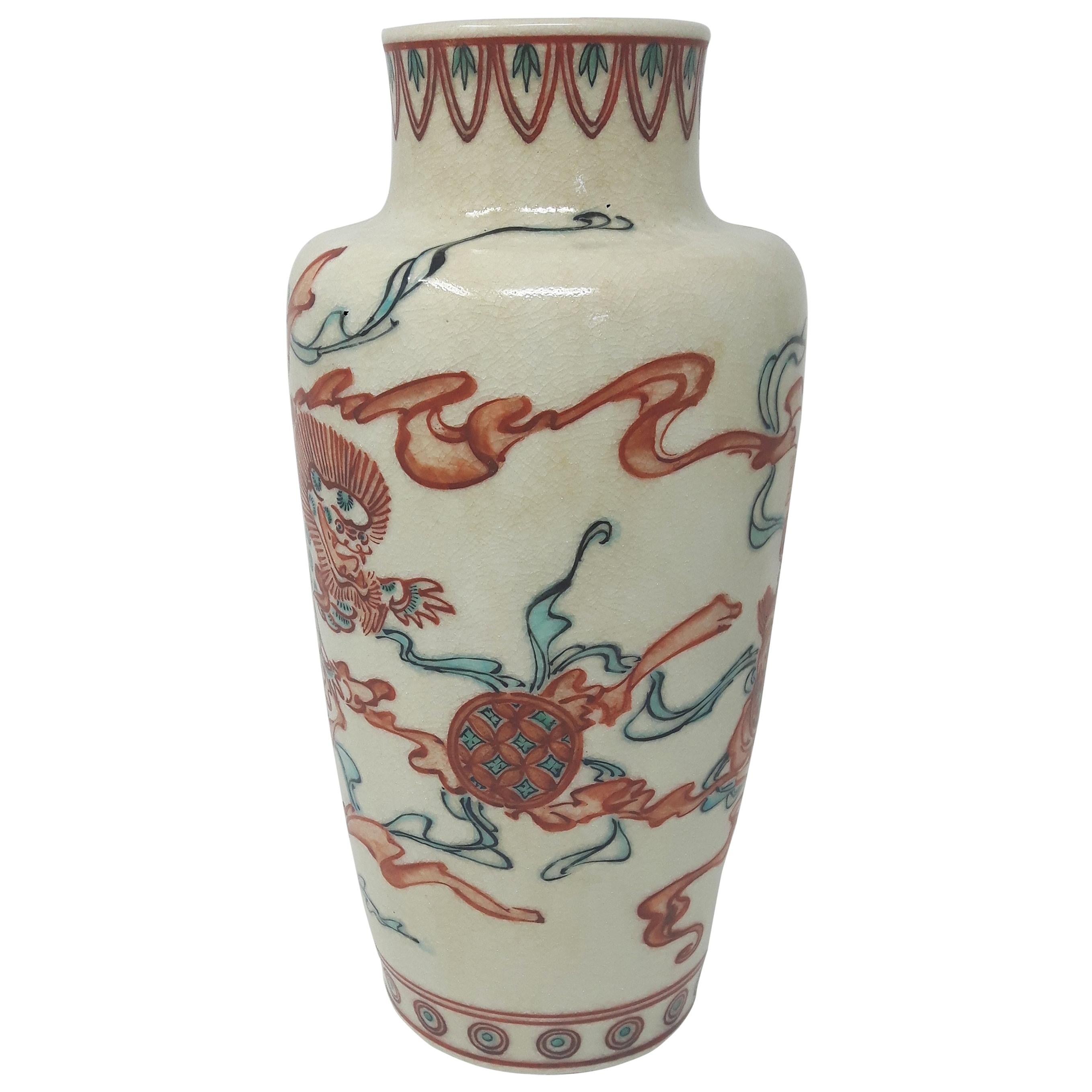Items Similar to Rare Japanese Porcelain Painted Footed Dish Makuzu Kozan
Want more images or videos?
Request additional images or videos from the seller
1 of 19
Rare Japanese Porcelain Painted Footed Dish Makuzu Kozan
About the Item
A rare footed dish in the form of an open scroll painting with literati landscape from the studio of Japanese Potter Makuzu Kozan. Also known as Miyagawa Kozan (1842–1916), Makuzu was one of the most established ceramists from Meiji Period. Born as Miyagawa Toranosuke, Kozan established his pottery studio in Yokohama around 1870s and later became one of the appointed artists to the Japanese Imperial household. His work was exhibited in many international fairs that the Meiji government participated at the turn of the century and won many grand prizes.
The unusual design was a smart play with both form and concept. The scroll opens to reveal an actual ink landscape painting that depicts a thatched hermitage under towering pines set in a mountainous scenery. Faint blue color was used to depict peak afar in the mist and also a very subtle full moon shape vignette, both very poetic touch with an intention to create a dimensional ambience. A small grove of bamboo and a sculptural plum tree with strokes of branches bearing the flowers complete the concept of "Three Winter Friends", a literary and pictorial metaphor of purity in a gentleman's character. The tropic of hermit who was tired of the corrupted court life and retreated back in nature has always been a favorite for ancient Chinese composition in both literature and art. This bowl embodies such a spirit. The bowl was supported by a foot ring and the underside was partially glazed black to add a strong visual effect. The bowl was likely used during a themed tea ceremony to present the sweets to the esteemed guest. It was signed with an impressed seal "Makuzu" on the base. The bowl has a very small historical kintsugi repair on one corner and a speckle on the bottom as well. The golden lacquer was intentional chosen to contrast the black glazed background, a wabi Sabi effect that was pursued to the aesthetic perfection.
A nearly identical dish with a variation of the painting is illustrated (no 40) on page 64 in the book "Bridging East and West: Japanese Ceramics from the Kozan Studio" by Emerson-Dell.
- Creator:Makuzu Kozan (Artist)
- Dimensions:Height: 2.75 in (6.99 cm)Width: 8 in (20.32 cm)Depth: 5.3 in (13.47 cm)
- Style:Meiji (Of the Period)
- Materials and Techniques:Porcelain,Glazed
- Place of Origin:
- Period:1900-1909
- Date of Manufacture:1900s
- Condition:Wear consistent with age and use. Fine antique condition with small spotted historical kintsugi repair as shown.
- Seller Location:Atlanta, GA
- Reference Number:1stDibs: LU945036842772
About the Seller
5.0
Platinum Seller
These expertly vetted sellers are 1stDibs' most experienced sellers and are rated highest by our customers.
Established in 2006
1stDibs seller since 2010
480 sales on 1stDibs
Typical response time: <1 hour
- ShippingRetrieving quote...Ships From: Atlanta, GA
- Return PolicyA return for this item may be initiated within 2 days of delivery.
More From This SellerView All
- Rare Large Japanese Porcelain Presentation Plate Makuzu KozanBy Makuzu KozanLocated in Atlanta, GAA large presentation plate with striking pictorial design from the studio of Japanese Potter Makuzu Kozan. Also known as Miyagawa Kozan (1842–1916),...Category
Early 20th Century Japanese Meiji Ceramics
MaterialsPorcelain
- Japanese Ceramic Centerpiece Bowl Makuzu Kozan Meiji PeriodBy Makuzu KozanLocated in Atlanta, GAA beautiful ceramic vessel in the form of Bo, the so-called monk's alms bowl from the studio of Japanese Potter Makuzu Kozan, also known as Miyagawa Kozan (1842–1916), one of the most established and collected ceramist from Meiji Period. Born as Miyagawa Toranosuke, Kozan established his pottery studio in Yokohama circa 1870s and later became one of the appointed artists to the Japanese Imperial household. His work was exhibited in many international fairs that the Meiji government participated at the turn of the century and won many grand prizes. Of a relatively large size, this piece was made as a decorative center piece for display. It was brilliantly decorated with underglaze paint of a green-on-green bamboo motif, using the novel technique developed by Kozan called Fuki-e (the blow painting). As a result, the bamboos appear took on a three-dimensional quality as if appearing in a mist. Known as one of the most creative ceramists, circa 1887, Kozan started experimenting with new chemical colors from the West in the format of his porcelain glaze. New colors allowed him to create underglaze design that appeared bright, smooth and glossy. To create design that is realistic and dimensional, more common in the western paintings, he was inspired by the native Japanese ink painting technique developed around 1900 by Yokoyama Taikan...Category
Antique Early 1900s Japanese Japonisme Ceramics
MaterialsCeramic
- Rare Japanese Porcelain Incense Burner with Inlays Makuzu KozanBy Makuzu KozanLocated in Atlanta, GAA porcelain incense burner (koro) made by Japanese potter Makuzu Kozan (also known as Miyagawa Kozan, 1842-1916) circa 1890s-1900s (end of Meiji Period). The koro features an elegant...Category
Antique Late 19th Century Japanese Meiji Ceramics
MaterialsCeramic
- Japanese Porcelain Vase Meiji Period Makuzu KozanBy Makuzu KozanLocated in Atlanta, GAA finely decorated and glazed Japanese porcelain vase by Makuzu Kozan (1842-1916) circa 1900s Meiji Period. The vase is of a classic bottle form with baluster body and short neck. It was decorated with underglaze white magnolia blossom on a pleasant celadon background. The stamens of the flower were artistically rendered in a low relief, giving the design a realistic appeal with the dimension. Miyagawa Kozan...Category
Early 20th Century Japanese Meiji Ceramics
MaterialsPorcelain
- Rare and Large Japanese Porcelain Vase Makuzu KozanBy Makuzu KozanLocated in Atlanta, GAA striking blue and white vase from the studio of Japanese Potter Makuzu Kozan, also known as Miyagawa Kozan (1842–1916), one of the most established and collected ceramist from Meiji Period. Born as Miyagawa Toranosuke, Kozan established his pottery studio in Yokohama around 1870s and later became one of the appointed artist to the Japanese Imperial household. His work was exhibited in many international fairs that the Meiji government participated at the turn of the century and won many grand prizes. With an impressively large size, this vase was likely made and reserved as a presentation piece for one of the many expositions the studio participated in the early 20th century. It was decorated with underglaze cobalt blue using the novel technique developed by Kozan called Fuki-e (the blow painting), in order to achieve the striking dimensional literary landscape known as "Mountain and Water". Being one of the most creative ceramists, Kozan started experimenting with new chemical colors from the West in the format of his porcelain glaze around 1880s. New colors allowed him to create underglaze designs that appeared bright, smooth and glossy. He even invented his own receipt of cobalt blue to achieve a much brighter yet softer shade, as evident on this vase. To create landscape that is realistic and dimensional, more common in the western paintings, he was inspired by the native Japanese ink painting technique developed around 1900 by Yokoyama Taikan...Category
Early 20th Century Japanese Japonisme Ceramics
MaterialsPorcelain
- Japanese Porcelain Vase Makuzu Kozan Meiji PeriodBy Makuzu KozanLocated in Atlanta, GAA striking blue and white vase from the studio of Japanese Potter Makuzu Kozan, also known as Miyagawa Kozan (1842–1916), one of the most established and collected ceramist from Meiji Period. Born as Miyagawa Toranosuke, Kozan established his pottery studio in Yokohama circa 1870s and later became one of the appointed artists to the Japanese Imperial household. His work was exhibited in many international fairs that the Meiji government participated at the turn of the century and won many grand prizes. Of a relatively large size, this vase is decorated with underglaze cobalt blue using the novel technique developed by Kozan called Fuki-e (the blow painting). As a result, the bamboos appear took on a three-dimensional quality as if appearing in a mist. Known as one of the most creative ceramists, circa 1887, Kozan started experimenting with new chemical colors from the West in the format of his porcelain glaze. New colors allowed him to create underglaze design that appeared bright, smooth and glossy. He even invented his own receipt of cobalt blue to achieve a much brighter yet softer shade, as evident on this vase. To create landscape that is realistic and dimensional, more common in the western paintings, he was inspired by the native Japanese ink painting technique developed around 1900 by Yokoyama Taikan...Category
Antique Early 1900s Japanese Japonisme Ceramics
MaterialsCeramic
You May Also Like
- Unusual Early 20th Century Makuzu Kozan VaseBy Makuzu KozanLocated in London, GBDecorated in iron-red and green enamels with an overall design of three shish frolicking with a brocade ball, signed on the base with an impressed seal Makuzu. The storage box ti...Category
Early 20th Century Japanese Meiji Ceramics
MaterialsPorcelain
- Large Japanese Ceramic Vase by Makuzu KozanLocated in Christchurch, GBAs part of our Japanese works of art collection we are delighted to offer this tapering square form Meiji Period 1868-1912, ceramic vase from the studios of the highly coveted Imperi...Category
Antique 19th Century Japanese Ceramics
MaterialsCeramic
- Japanese Ceramic Vase by Makuzu KozanBy Makuzu Kozan IILocated in Christchurch, GBAs part of our Japanese works of art collection we are delighted to offer this charming Meiji Period 1868-1912, ceramic baluster vase from the studios of the highly coveted Imperial ...Category
Antique 19th Century Japanese Meiji Ceramics
MaterialsCeramic
- Unusual Japanese Studio Vase by Makuzu Kozan IIBy Makuzu Kozan IILocated in Christchurch, GBAs part of our Japanese works of art collection we are delighted to offer this most unusual Late Meiji (1868-1912) early Taisho period (1912-1926 ), globular vase stemming from the h...Category
Vintage 1920s Japanese Taisho Ceramics
MaterialsEarthenware
- Charming Japanese Okimono Mandarin Ducks - Makuzu Kozan IIBy Makuzu Kozan IILocated in Christchurch, GBAs part of our Japanese works of art collection we are delighted to offer this most charming late Meiji (1868-1912) Taisho period (1912-1926) , ceramic study of Mandarin ducks from ...Category
Vintage 1920s Japanese Taisho Ceramics
MaterialsCeramic
- Captivating Japanese Stoneware Jardiniere by Makuzu Kozan IIBy Makuzu Kozan IILocated in Christchurch, GBAs part of our Japanese works of art collection we are delighted to offer this most captivating Late Meiji (1868-1912) early Taisho period (1912-1926 ),globular stoneware vessel stem...Category
Vintage 1920s Japanese Taisho Ceramics
MaterialsStoneware
Recently Viewed
View AllMore Ways To Browse
Blue China Tea Set
Antique Japanese Tea Ceremony Paintings
Black Seal Ring
Japanese Meiji Period Satsuma Porcelain
Copper Matte Raku
Antique Chinese Cloud Collars
Saki Pots
Asian Porcelain Fish Bowl
Chinese Emperor And Empress
Mille Fleur Porcelain
Qing Floor Vase
Chinese Export Carp
Chinese Warrior Roof Tile
Kitaoji Rosanjin
Kutani Crane
Kutani Yaki
Ming Dynasty Chenghua
Ming Dynasty Porcelain Chenghua





